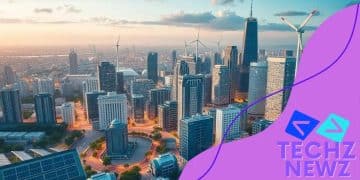Autonomous vehicles and urban infrastructure changes

Autonomous vehicles significantly impact urban infrastructure by necessitating upgrades to existing systems for safety, efficiency, and integration of smart technology, which can enhance traffic flow and improve the overall quality of urban living.
Autonomous vehicles and urban infrastructure changes are more than just tech trends; they’re reshaping our cities. Have you considered how self-driving cars might influence your daily commute or the layout of your neighborhood? Let’s dive into this evolving topic.
Impact of autonomous vehicles on public transport
The impact of autonomous vehicles on public transport is likely to be profound. With the rise of self-driving cars, public transport systems may need to adapt in significant ways. These vehicles can enhance existing transportation services, making them more efficient and accessible.
One major area where changes will occur is in the way routes are planned. Autonomous vehicles allow for greater flexibility in adjusting routes based on demand. For instance, if a certain area experiences higher demand, services can be quickly rerouted to accommodate passengers.
Benefits of integrating autonomous vehicles into public transport
When we think about the integration of autonomous vehicles into public transport, several benefits stand out:
- Increased Accessibility: Self-driving cars can provide services to individuals in underserved areas, enhancing mobility.
- Cost Reduction: With fewer drivers needed, operational costs for public transport systems could decrease significantly.
- Improved Safety: Autonomous vehicles can reduce human error, potentially leading to lower accident rates.
- Environmental Impact: Many autonomous vehicles are electric, which can help decrease air pollution.
Moreover, these vehicles can work in tandem with existing public transport options, such as buses and trains. For example, autonomous shuttles could provide first-mile and last-mile services, connecting passengers to major transit hubs easily. This synergy between public transport and autonomous systems can lead to a more efficient overall transportation network.
However, there are challenges to consider. Infrastructure will need significant upgrades to accommodate autonomous technology. Considerations such as dedicated lanes for self-driving buses and improved traffic signals are necessary to ensure safety and efficiency. Additionally, public acceptance is crucial. Educating citizens about safety and benefits will foster trust in autonomous vehicles.
As technology develops, it’s exciting to envision a future where autonomous vehicles seamlessly integrate into our public transport systems. This transformation can lead to smarter, more connected urban areas, making travel easier and promoting sustainable practices. The shift toward autonomous public transport isn’t just about cars; it’s about rethinking how we move around and interact with our cities.
Redesigning urban infrastructure for safety
Redesigning urban infrastructure for safety in the age of autonomous vehicles is essential. As these cars become more prevalent, cities must adapt their roads, signage, and traffic systems to optimize safety for all users. This transformation requires a new approach to urban design that prioritizes the harmony between human interactions and technology.
One way urban designers can enhance safety is by implementing smart traffic signals. These signals can communicate with autonomous vehicles to provide real-time data, ensuring smoother traffic flow. This feature can help prevent accidents by allowing vehicles to anticipate changes in traffic patterns.
Key elements of urban safety redesign
When thinking about redesigning infrastructure for safety, several key elements come into play:
- Dedicated lanes for autonomous vehicles: Creating separate lanes can minimize conflicts between human-driven and self-driving cars.
- Improved pedestrian crossings: Enhanced crosswalk designs and signals can better protect pedestrians from oncoming traffic.
- Enhanced lighting: Better street lighting can improve visibility at night, reducing accidents.
- Use of technology: Integrating sensors and cameras can help monitor traffic conditions and identify potential hazards.
Furthermore, the redesign should address cyclists and pedestrians. By including protected bike lanes and wider sidewalks, cities can create safer environments for everyone. This integration promotes a more balanced urban mobility system, where everyone can coexist peacefully.
In addition, public feedback plays a vital role in creating safe urban infrastructures. Involving residents in the planning process can lead to more effective solutions tailored to community needs. As autonomous vehicles continue to change the landscape, prioritizing safety will ensure that urban areas remain livable and accessible for future generations.
How autonomous cars affect traffic flow

Understanding how autonomous cars affect traffic flow is vital for our cities. These vehicles can make roads safer, more efficient, and less congested. By communicating with each other and the traffic system, autonomous cars can optimize how they move through urban areas.
One significant change is how these vehicles can reduce traffic jams. Autonomous cars can adjust their speeds and routes based on real-time information, which helps maintain a smoother flow of traffic. This ability can lead to fewer sudden stops and starts, making commutes quicker and more pleasant.
Benefits of autonomous vehicles on traffic flow
The potential benefits include:
- Reduced congestion: With better coordination, fewer vehicles will be on crowded roads.
- Improved travel times: Traffic can move more freely, allowing for quicker journeys.
- Safer roads: Decreased human error can lead to fewer accidents.
- Less fuel consumption: With smoother driving patterns, vehicles can use fuel more efficiently, leading to lower emissions.
Moreover, autonomous cars can adapt to peak traffic times. They can reroute themselves to less congested pathways, which significantly decreases delays. This adaptability is vital for urban planning, as cities seek to manage growing populations and increased vehicle usage.
However, the transition to autonomous vehicles will come with challenges. Infrastructure must evolve to support these changes. Road markings, traffic lights, and signals must all be upgraded to enable effective communication. Additionally, a mixed environment where human drivers share the road with autonomous vehicles may create confusion, requiring education and adjustment time for everyone.
In summary, by understanding how autonomous cars affect traffic flow, cities can prepare for a future where mobility is seamless, safe, and efficient. This transformation may revolutionize our daily travel experiences and change the way we perceive urban transportation.
Integration of smart technology in cities
The integration of smart technology in cities is transforming urban living. Cities are becoming more connected and efficient, thanks to advancements in technology that manage resources and enhance the quality of life for residents. This shift not only supports the infrastructure but also improves safety and convenience.
Smart technology enables better monitoring of urban systems. For example, smart sensors can track traffic patterns and optimize signal timing, ensuring a smoother flow of vehicles. This technology can also help monitor air quality and control pollution levels, making cities healthier places to live.
Key aspects of smart technology integration
Several key aspects stand out when considering how cities can implement this technology:
- Data collection: Gathering data from various sources can help city planners make informed decisions.
- Public safety: Smart cameras and sensors can enhance security by monitoring high-traffic areas.
- Energy efficiency: Smart grids can optimize energy use and integrate renewable sources effectively.
- Mobility solutions: Applications can provide real-time information on public transport and traffic conditions.
In addition to these applications, integrating smart technology fosters community engagement. Citizens can use mobile apps to report issues like potholes or broken streetlights, making them active participants in maintaining their neighborhoods. Furthermore, improved communication tools can keep residents informed about city services, making the urban experience more user-friendly.
Despite the benefits, challenges remain. Privacy concerns are paramount as cities gather data from residents. Implementing robust data protection measures is essential to build trust in smart city initiatives. Additionally, the digital divide must be addressed to ensure that all residents benefit from advancements in technology, not just those with access to the latest devices.
By embracing smart technology, cities can become more adaptive and resilient. This integration allows for more personalized services, ultimately enhancing the quality of life for everyone. As urban areas continue to grow, leveraging smart solutions will be crucial for creating sustainable environments that meet the needs of current and future generations.
Challenges and opportunities in infrastructure adaptation
Adapting infrastructure for the rise of autonomous vehicles presents both challenges and opportunities. As cities evolve to accommodate these technological advances, they must tackle various issues while also embracing the potential benefits.
One challenge is the need for significant investment in upgrading current infrastructure. Many roads, bridges, and public transport systems were designed for traditional vehicles. This means cities will need to allocate funds for smart traffic signals, dedicated lanes for self-driving cars, and enhanced safety features. Additionally, existing roadways may require redesigns to facilitate communication between vehicles and infrastructure.
Key challenges of infrastructure adaptation
Some of the notable challenges include:
- Cost: Upgrading infrastructure can be expensive and time-consuming.
- Integration: Ensuring that new systems work well with existing ones can be complex.
- Regulation: Cities must navigate regulations and policies to implement new technologies.
- Public acceptance: Gaining trust from residents regarding the safety and effectiveness of autonomous technology is essential.
On the flip side, there are numerous opportunities that emerge with these adaptations. By embracing new technologies, cities can create more efficient transportation systems, potentially reducing traffic congestion and improving air quality. Infrastructure that accommodates autonomous vehicles can also enhance safety, as these vehicles are often equipped with advanced sensors and communication capabilities.
Additionally, adapting infrastructure can encourage innovation. Cities can become testing grounds for new technologies, attracting investments and fostering job creation in the tech sector. Enhanced public transport systems can also lead to increased usage, promoting sustainable urban mobility and reducing reliance on personal vehicles.
Moreover, the integration of smart technology allows for real-time data collection. This information can help urban planners make informed decisions about traffic management and resource allocation. By analyzing usage patterns, cities can optimize their infrastructure for current and future demands, ensuring a better quality of life for residents.
In summary, while there are challenges in adapting infrastructure for autonomous vehicles, the potential opportunities for safer, smarter, and more efficient urban environments are significant. Embracing these changes can lead to lasting benefits that improve urban living for everyone.
In conclusion, the transition to autonomous vehicles will significantly reshape our urban landscapes. By integrating smart technologies and adapting infrastructure, cities can become safer, more efficient, and environmentally friendly. The challenges we face are outweighed by the opportunities for innovation, improved mobility, and enhanced quality of life. As we embrace this change, collaboration among city planners, technology developers, and communities will be vital to successfully navigate the future of urban transportation.
FAQ – Frequently Asked Questions about Autonomous Vehicles and Urban Infrastructure
What are the main benefits of integrating autonomous vehicles into urban transport?
The integration can lead to improved safety, reduced traffic congestion, and more efficient public transportation systems.
What challenges do cities face when adapting infrastructure for self-driving cars?
Cities must invest significantly in upgrades, ensure new technologies work with existing systems, and address public concerns about safety and regulation.
How can smart technology improve traffic flow in cities?
Smart technology can facilitate real-time communication between vehicles and traffic systems, leading to smoother traffic patterns and fewer jams.
Why is community involvement important in this transition?
Community feedback helps ensure that infrastructure meets the needs of residents and fosters trust in new technologies during the adaptation process.





